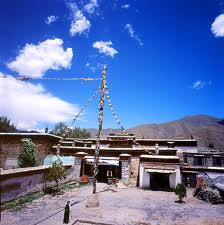Tradruk Temple
Tradruk Temple, also written Changzhug Monastery (Tibetan: ཁྲ་འབྲུག་དགོན་པ།, Wylie: khra-’brug dgon-pa, ZYPY: Changzhug Gönba, Lhasa dialect IPA: [ʈʂʰaŋʈʂuk kø̃pa]), in the Yarlung Valley is the earliest great geomantic temple after the Jokhang - and some sources say it is even pre-dates the Jokhang.
It is located in Nêdong County of Lhoka (Shannan) Prefecture in the Tibet Autonomous Region of China, about seven kilometres south of the county seat Tsetang (Tibetan: རྒྱལ་རྩེ།, ZYPY: Zêtang).
Founding legends
Changzhug Monastery is the largest and most important of the surviving royal foundations in the Yarlung Valley.
It is said to have been founded in the 7th century under king Songtsen Gampo.
According to one legend, Changzhug was one of twelve geomantic temples, Tadü (མཐའ་འདུལ་ mtha’ ’dul) and Yangdü (ཡང་འདུལ་ yang ’dul), which were built to hold down the huge supine ogress Sinmo (སྲིན་མོ་ srin mo, Sanskrit [[राक्षसि rākṣasi) under Tibet: Tradruk was said to stand on her left shoulder, Gazai (ཀ་རྩལ་ ka rtsal / བཀའ་ཚལ་ bka’ tshal / བཀའ་རྩལ bka’ rtsal) bei Gyama (རྒྱ་མ་ rgya ma / Jiǎmǎ 甲马) in Maizhokunggar County (མལ་གྲོ་གུང་དཀར་རྫོང་ mal gro gung dkar rdzong / Mòzhúgōngkǎ Xiàn 墨竹工卡县) on her right shoulder and the Qokang in Lhasa on her heart.
According to another legend, at the site of the monastery there was originally a lake inhabited by a dragon with five heads. Songzain Gambo was able to call a huge falcon by meditation, which defeated the dragon and drank all the water of the lake, so that the temple could be built. This legend would explain the name of the temple.
History
Tradruk is said to have been the second of Tibet's earliest great geomantric temples after the Jokhang, and some sources even place it arlier. Under the rule of Trisong Detsen (755–797) and Muné Tsenpo, Tradruk was one of the three royal monasteries.
During the persecution of Buddhism under Langdarma (glang dar ma, 841–846) and during the Mongol invasion from Junggaria (northern modern Xinjiang) in the 16th century, the monastery was heavily damaged.
In 1351, Tradruk was restored and enlarged; during the reign of the 5th Dalai Lama (1642–1682), the monastery got a golden roof and under the 7th Dalai Lama (1751–1757), it was further expanded. In the late 18th century, Tradruk is said to have had 21 temples. Several buildings were destroyed during the Cultural Revolution.
During the 1980s, the monastery was renovated and in 1988 it was consecrated again. Today, the complex has an area of 4667 square metres and is under national protection.
Architecture and craftwork
The centre of the temple is the innermost chapel, which is said to date back to the original temple built by Songtsen Gampo; according to the legend, it held Buddha statues of stone and a Tara statue. Today, the chapel houses clay figures which are said to contain fragments of the original statues.
The most important treasure of Tradruk is a Tangka embroidered with thousands of pearls, which is said to have been made by princess Wen Cheng herself. It depicts Wen Cheng as White Tara. The Tangka is kept in the central chapel on the upper floor. It is one of only three Tangkas made by Wen Cheng. The two other ones are in the reliquary stupa of the 5th Dalai Lama in the Potala in Lhasa and in Shigatse. There is a famous "talking" statue of Padmasambhava at the age of eight years in the same room in Tradruk.
Tradruk used to have a famous bell on the verandah which is not in the monastery any more with an inscription containing the name of Khri-song-lde-btsan (Trisong Detsen), who probably enlarged and embellished the original buildings.
The inscription on the bell read:
- "This great bell was installed here to tell the increase of the life-time of the divine btsan-po Khri Lde-srong-brtsan.The donor Queen Byang-chub had it made to sound like the sound of the drum roll of the gods in the heavens and it was cast by the abbot, the Chinese monk Rin-cen as a religious offering from Tshal and to call all creatures to virtue."
The main building is surrounded by several smaller shrines.
Rituals
Each year in June, ritual dances are staged at Tradruk, known as Mêdog Qoiba (me tog mchod pa, “flower offering”).
